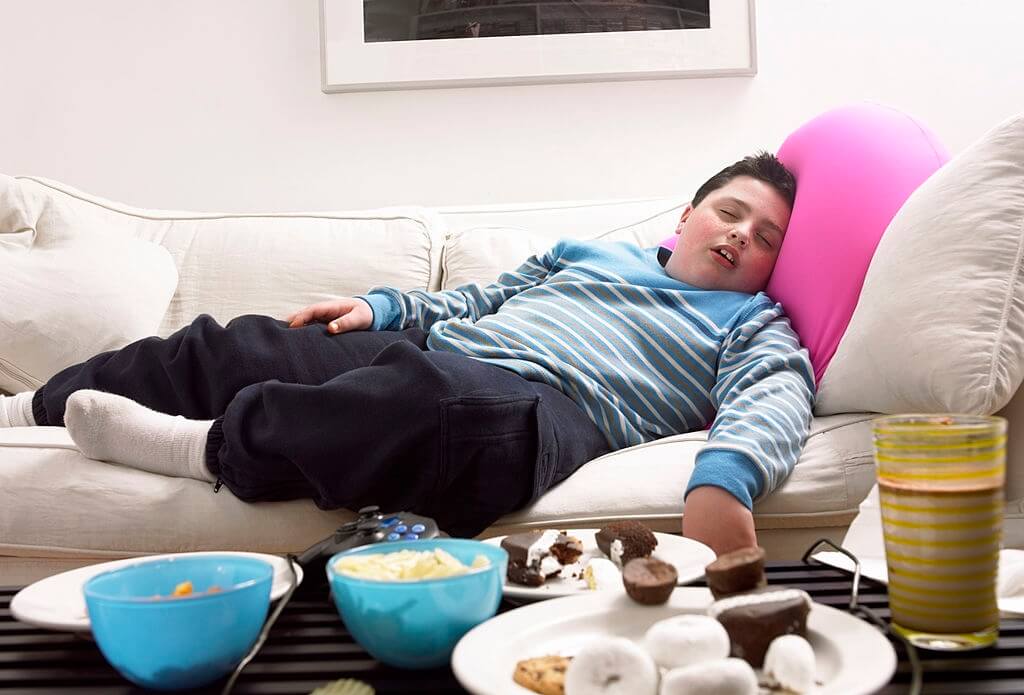Obesity is associated with several respiratory dysfunctions. Overweight individuals have an increased need for pulmonary ventilation, the load on the respiratory muscles increases. At the same time, their efficiency decreases, the volume of the functional reserve of the lungs decreases, and a tendency to bronchospasm is observed. This leads to ventilation-perfusion imbalance, especially in the supine position.
Sleep Apnea and Obesity
Obesity is the most common cause of alveolar hypoventilation. For the first time, the phenomena of obstructive dyspnea were described in an obese patient. For a long time, the term “Pickwick’s syndrome” was used to denote hypoventilation syndrome in obese individuals. Obesity is a relatively common cause of respiratory failure and pulmonary hypertension, leading to obstructive sleep apnea syndrome (OSAS).

Sleep apnea and obesity are characterized by:
· Loud snoring
· Pauses in breathing during sleep,
· Increased urination at night
· Arterial hypertension,
· Rhythm disturbances
· Excessive daytime sleepiness
· Decrease in potency,
· Personality change (irritability, memory loss).
In recent years, there has been a significant increase in sleep-related breathing disorders among overweight individuals, and obesity is considered the most important modifiable risk factor for OSAS. The prevalence of the syndrome is 5 – 7% of the total population over 30 years old, but in most cases, this syndrome is not recognized in obese individuals. The problem is that conventional examination methods often fail to detect any changes. The primary way for sleep apnea and obesity verification is polysomnography, which allows long-term recording of various functions of the human body during the period of nocturnal sleep. Polysomnography is performed in sleep laboratories with appropriate diagnostic equipment.
Thus, obesity can affect many pathological processes associated with each other, including the combined occurrence of OSAS, arterial hypertension, and atherosclerosis in one patient. It should be emphasized that clinical and electrocardiographic signs of cor pulmonale appear only after a lapse of time after the onset of pulmonary hypertension. Patients with OSAS have an increased risk of developing:
· Arterial hypertension (both at night and during the day).
· Heart rhythm disturbances at night.
· Pulmonary hypertension.
· Right ventricular or left ventricular heart failure.
· Stroke.
Even many doctors believe that obstructive sleep apnea is a problem exclusively for obese patients. To some extent, this belief is well-grounded because being overweight is indeed a high-risk factor for developing sleep-disordered breathing. However, not everything here is as simple and unambiguous as it might seem at first glance to an inexperienced person.
Obesity does not always result in sleep apnea.
Breathing pauses during sleep do not occur in all obese people. Recent studies have shown that the development of this disease is primarily affected by the amount of body fat in the cervical region: the larger the neck girth, the more narrowed the airways, especially when a person is in the supine position. And the easier they can close, thereby creating an obstacle to the normal flow of air. Total body weight plays a secondary role here. To accurately assess the risks of developing sleep apnea, you need to take into account not the amount of subcutaneous fat but the amount of internal, so-called visceral fat.
Indirect signs that an overweight person is at risk of sleep apnea are a large neck circumference and abdominal volume at the level of the fourth lumbar vertebra. Therefore, it is not always possible to identify sleep apnea in obese people, but not all people who believe their weight is approximately within the normal range are healthy.
What methods are used to treat sleep apnea?
1. Conservative treatment (in mild cases of sleep apnea):
Weight loss. Even a loss of only 10% of weight can improve breathing parameters for most patients.
Avoid drinking alcohol before bed.
Try sleeping on your side. In some patients with early-stage sleep apnea, breath-holding occurs only when they sleep on their back. If you find it difficult to give up your usual sleeping position, use pillows and bolsters for more comfort. For nasal congestion or an exacerbation of chronic sinus disease, the patient should use nasal sprays or decongestants to ease breathing.
Use constant positive airway pressure.
Constant positive airway pressure (CPAP) therapy is the preferred treatment for obstructive sleep apnea. CPAP is a mouth and nose mask. The air pressure is regulated in such a way that the power is sufficient. CPAP prevents the airway from closing during use, but episodes of apnea return when the device is turned off or used inappropriately. Other types of devices are offered to patients who have difficulty using CPAP.
Use of Device for extending the lower jaw.
Device for extending the lower jaw forward for the treatment of mild apnea (MAD). The device prevents the tongue from blocking the throat. These devices help keep the airways open while you sleep.
Surgical treatment
If breathing through the nose and throat is too difficult, doctors turn to surgical treatment. Difficulty breathing can be caused by: a curved nasal septum, significantly enlarged tonsils, a small lower jaw with an irregular bite. Operation types:
Somnoplasty is a surgical technique aimed at reducing the oversized tissue of the soft palate using radiofrequency ablation.
Uvulopalatopharyngoplasty (UPPP) is an operation indicated for the treatment of obstructive sleep apnea. During the procedure, the tonsils, part of the soft palate, and uvula are removed. As a result, the opening of the throat expands, the passage of air is not impeded, which eliminates or significantly facilitates snoring and apnea.
Apnea often leads to obesity by itself.
There is growing evidence that sleep apnea also affects a person’s weight very negatively. Sleep disorders and nighttime oxygen starvation, which characterize this condition, lead to disruptions in the secretion of several essential hormones involved in fat metabolism. As a result, an excess of calories is actively converted into fat, its amount in the body increases, but the volume of bone and muscle tissue, on the contrary, decreases.
In addition, sleepiness inherent in patients with obstructive sleep apnea interferes with routine physical activity, and a sedentary lifestyle becomes another prerequisite for gaining excess weight and difficulty losing weight.
Researchers have long noted a bi-directional relationship between sleep apnea and obesity: being overweight threatens the development of sleep apnea, which in turn threatens the progression of obesity.
And it also happens that a person who does not seem to have extra pounds begins to gain excess weight quickly enough. Suppose a noticeable increase in body weight is accompanied by poor sleep with snoring, increased blood pressure in the morning, chronic fatigue, and drowsiness. In that case, you should visit a somnologist and check if all these symptoms are associated with breathing disorders during sleep.
Is losing weight the best solution?
If a person decides to normalize his weight and adjusts his diet, surprises can also arise here, and quite unpleasant ones. First, an unbalanced diet negatively affects the quality of night sleep and its structure. And since many people like us come up with diets on their own and choose the most “tough” options, counting on the fastest possible success, there is a high risk that from such a diet, extra pounds not only will not go away, but then they will also increase. Low-calorie diets lead to an increase in the time to fall asleep and a decrease in the duration of the slow-wave sleep phase, which adversely affects the state of metabolism.
Secondly, people trying to sit on a super-strict diet are inherent in the so-called “food breakdowns,” when, denying themselves adequate nutrition during the day, in the evening they can not stand it and eat the same “forbidden yummy.” High-carbohydrate food before bed reduces the secretion of the sleep hormone melatonin and also significantly degrades its quality.
Sleep apnea and obesity syndrome in children

In children, enlarged tonsils or adenoids, certain dental conditions (such as severe deep bite), obesity, and certain malformations (such as an unusually small lower jaw) can lead to obstructive sleep apnea. Seasonal allergies that cause severe nasal congestion can worsen sleep apnea.
Other symptoms during sleep may include restless sleep and night sweats. Some children wet the bed. Daytime symptoms may include mouth breathing, headache upon waking, and trouble concentrating. Learning problems and certain behavioral problems (such as hyperactivity, impulsivity, and aggression) are common symptoms of severe obstructive sleep apnea in children. Growth retardation can also occur in children. Excessive daytime sleepiness is less common in children than in adults with obstructive sleep apnea.
In conclusion, all these factors ultimately lead to the fact that the weight does not disappear anywhere or even increases, sleep does not improve, but even gets worse, and apnea continues to progress. What to do in such a situation? Consult with specialists first. And treat sleep apnea in parallel with the normalization of weight, and not “someday later.” And do not hope that “if I lose weight and stop breathing in a dream, they will stop by themselves.”
And it is unlikely that you will succeed in losing weight since apnea interferes with the process of losing weight, and apnea will not stop because, despite all your efforts, most likely, if it does, it will decrease slightly. Hormonal imbalance, leading to an imbalance between hunger and satiety, fat burning and weight gain, constant daytime fatigue leading to decreased physical activity, and serious cardiovascular problems will not allow you to become slimmer and feel better. But apnea affects our body in this way.